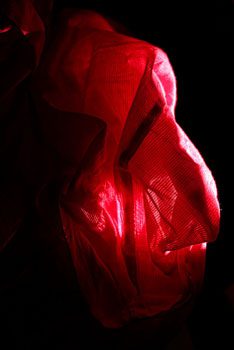Laura Loertscher
Portland, Oregon, United States

“Yes, definitely red—that’s what she would want.” Sarah and I met at the fabric store on a Sunday afternoon. Ducking in out of the heavy rain and the heavier slate sky, we were greeted by bolts of bright, colorful fabric. We both remembered the cherry sweater that Nancy wore into clinic and knew which color would suit her best.
In an era of resident work hour restrictions, overwhelming use of medical technology, and the portrayal of patients as customers, we may question our trainees’ ability to maintain a deep sense of humanism in medicine. I was struck by the profound doctor-patient relationship I had seen grow before me. It was a resident who understood that the trust of a patient hung by a thread. It was a resident who gained enough trust to guide this patient through a labyrinth of medical decisions, including some that we supervising physicians often feel ill-equipped or overwhelmed to undertake. It was a resident who invited me on one of her far-too-few days off to accompany her at a fabric store; she was going to make a skirt for Nancy.Nancy had first entered Sarah’s world on an unassuming Thursday. She presented to the emergency department of our hospital with a wound that shocked and dismayed her doctors. Her chief complaint was weakness, but her physical exam quickly revealed a right chest wall wound whose seeping soaked the hospital gown. A breast cancer neglected, ignored, or denied by a woman whose person had been too easily cast aside by others during her life. Whether from the same insecurity that delayed her pursuit of medical care or the inescapable glimpse of horror in the eyes of those meant to care for her, Nancy was wary of the doctors and nurses who suddenly surrounded her. She found in Sarah a warm face, a gentle touch, a calm presence, and a competent doctor. After initial stabilization in the hospital, Nancy established with Sarah as her primary care physician. And so I entered the picture as clinic preceptor for Sarah, a second-year internal medicine resident. Over the next eight months, I watched on as a gentle dance emerged between Sarah and Nancy, the grace present in their regular office visits a testament to the hard work behind the scenes of coordinating wound care, home health, anticoagulation, and advance-care planning. When her metastatic breast cancer progressed despite hormonal therapy and surgery, Nancy ultimately declined chemotherapy. It was those regular appointments, filled with trust rather than judgment, which allowed for a clear understanding of Nancy’s wishes and a seamless referral to hospice. During one of those many visits, Nancy complimented Sarah on a skirt that she had made for herself, and a seed was planted.
It was a colorful destination on a rainy day, and a joyful gesture for a woman whose red sweater could not cover the heartache she had endured. My four-week-old baby boy accompanied us on this excursion; his fresh smell a reminder of how delightful and fleeting a life can be. Nancy came to clinic for the last time on a December morning, but our journey together did not end quite yet.
On this day the drops fell more softly. It was a Thursday afternoon when I went with Sarah to visit Nancy at her daughter’s house, where she was quietly passing her days under the watchful care of hospice. A young child walked casually through the living room as the caregiver directed us to the basement. There in her garden level room laid Nancy, wrapped in a red robe. She glanced our way and an immediate spark appeared in her eye. “You came to visit me.”
We talked for a long while—a little bit about whether her pain was controlled and how much the wound was soaking through its dressing—but mostly about her grandchildren, and younger days, and the snapshot of her parents on the wall. She grinned and said, “Open that drawer next to the bed; that’s where I keep my candy.” I thought of the candy drawer at my own grandma’s house; its telltale creak warned not to sneak too many treats. A chocolate melted away in three satisfied mouths; Sarah and I said our goodbyes, gave Nancy a kiss on the forehead, and said that we would be back in a month. Only 10 days went by before we heard of her passing. That night I thought of Sarah and Nancy, and I inhaled extra deeply as I bent to kiss my baby boy’s cherry cheek.
LAURA LOERTSCHER, MD, practices and teaches internal medicine in Portland, Oregon. Her main clinical practice is in outpatient primary care, where she also precepts residents in their continuity clinic. She enjoys the variety and enthusiasm of the academic setting and finds particular joy in watching the growth of patient-doctor relationships. Other interests include teaching and mentoring quality improvement and value in healthcare. She lives with her husband and two young sons.
Highlighted in Frontispiece Winter 2013 – Volume 5, Issue 1

Leave a Reply